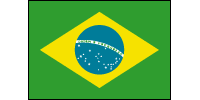| Country (long form) |
Federative Republic of Brazil |
| Capital |
Brasilia |
| Total Area |
3,286,488.06 sq mi
8,511,965.00 sq km
(slightly smaller than the US) |
| Population |
174,468,575 (July 2001 est.)
note: Brazil took an intercensal count in August 1996 which reported a population of 157,079,573; that figure was about 5% lower than projections by the US Census Bureau, which is close to the implied underenumeration of 4.6% for the 1991 census; estimates for this country explicitly take into account the effects of excess mortality due to AIDS; this can result in lower life expectancy, higher infant mortality and death rates, lower population and growth rates, and changes in the distribution of population by age and sex than would otherwise be expected |
| Estimated Population in 2050 |
206,751,477 |
| Languages |
Portuguese (official), Spanish, English, French |
| Literacy |
83.3% total, 83.3% male, 83.2% female (1995 est.) |
| Religions |
Roman Catholic (nominal) 80% |
| Life Expectancy |
58.96 male, 67.73 female (2001 est.) |
| Government Type |
federative republic |
| Currency |
1 real (R$) = 100 centavos |
| GDP (per capita) |
$6,500 (2000 est.) |
| Industry |
textiles, shoes, chemicals, cement, lumber, iron ore, tin, steel, aircraft, motor vehicles and parts, other machinery and equipment |
| Agriculture |
coffee, soybeans, wheat, rice, corn, sugarcane, cocoa, citrus; beef |
| Arable Land |
5% |
| Natural Resources |
bauxite, gold, iron ore, manganese, nickel, phosphates, platinum, tin, uranium, petroleum, hydropower, timber |
|


|